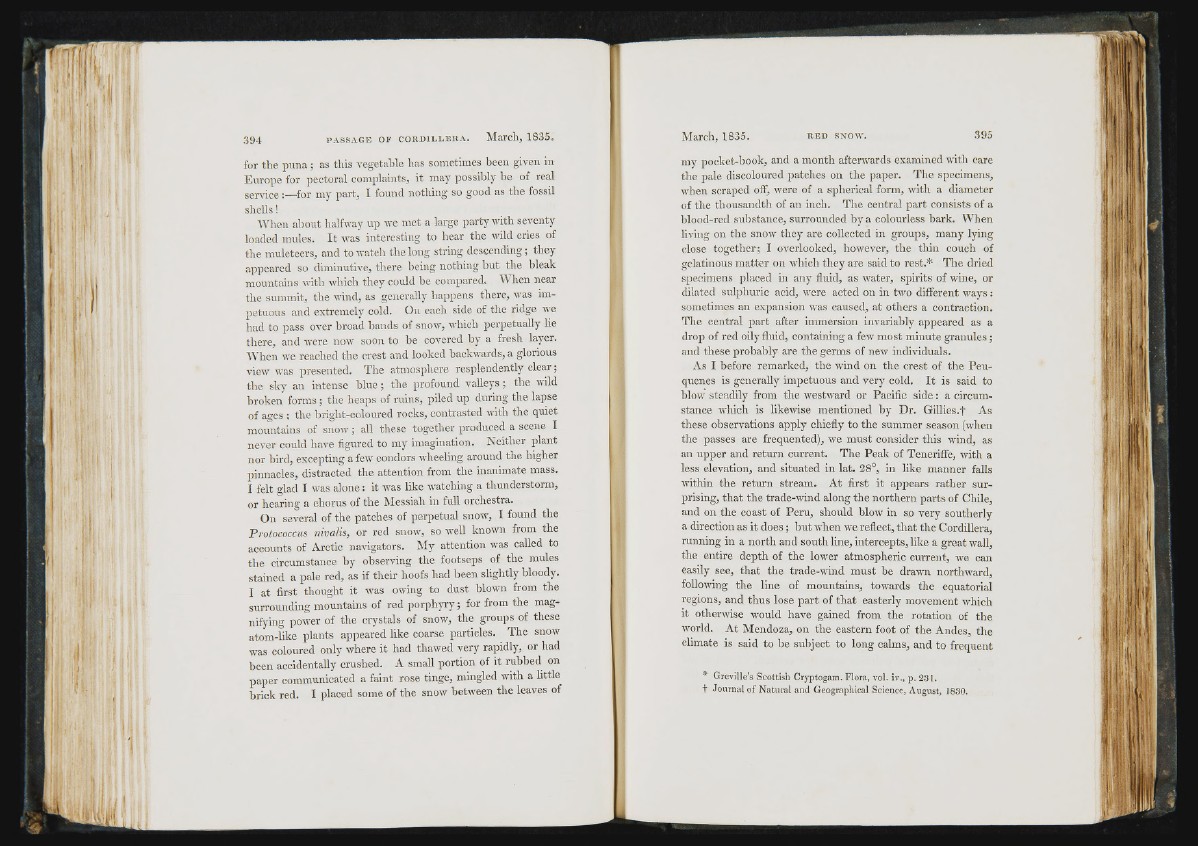
1
for the puna ; as this vegetable has sometimes been given iu
Evirope for pectoral complaints, it may possibly be of real
service:— for my part, I found nothing so good as the fossil
shells!
When about halfway up we met a large party with seventy
loaded mules. It was interesting to hear the wild cries of
the muleteers, and to watch the long string descending; they
appeared so diminutive, there being nothing but the bleak
mountains with which they could be compared. When near
the summit, the wind, as generally happens there, was impetuous
and extremely cold. On each side of the ridge we
had to pass over broad bands of snow, which perpetually lie
there, and were now soon to be covered by a fresh layer.
When we reached the crest and looked backwards, a glorious
view was presented. The atmosphere resplendently clear;
the sky an intense blu e ; the profound valleys; the wild
broken forms ; the heaps of ruins, piled up during the lapse
of ages ; the bright-coloured rocks, contrasted with the quiet
mountains of snow; all these together produced a scene I
never could have figured to my imagination. Neither plant
nor bird, excepting a few condors wheeling around the higher
pinnacles, distracted the attention from the inanimate mass.
I felt glad I was alone: it was like watching a thunderstorm,
or hearing a chorus of the Messiah in full orchestra.
On several of the patches of perpetual snow, I found the
Protococcus nivalis, or red snow, so well known from the
accounts of Arctic navigators. My attention was called to
the circumstance by observing the footseps of the mules
stained a pale red, as if their hoofs had been slightly bloody.
, at first thought it was owing to dust blown from the
surrounding mountains of red porphyry; for from the magnifying
power of the crystals of snow, the groups of these
I
atom-hke plants appeared like coarse particles. The snow
was coloured only where it had thawed very rapidly, or had
been accidentally crushed. A small portion of it rubbed on
paper communicated a faint rose tinge, mingled with a httle
brick red. I placed some of the snow between the leaves of
my pocket-book, and a month afterwards examined witli care
the pale discoloured patches on the paper. The specimens,
when scraped off, were of a spherical form, with a diameter
of the thousandth of an inch. The central part consists of a
blood-red substance, surrounded by a colourless bark. When
living on the snow they are collected in groups, many lying
close together; I overlooked, however, the thin couch of
gelatinous matter on which they are said to rest.* The dried
specimens placed in any fluid, as water, spirits of wine, or
dilated sulphuric acid, were acted on in two different ways :
sometimes an expansion was caused, at others a contraction.
The central part after immersion invariably appeared as a
drop of red oily fluid, containing a few most minute granules ;
and these probably are the germs of new individuals.
As I before remarked, the wind on the crest of the Peuquenes
is generally impetuous and very cold. It is said to
blow steadily from the westward or Pacific side : a circumstance
whioh is likewise mentioned by Dr. Gillies.t As
these observations apply chiefly to the summer season (when
the passes are frequented), we must consider this wind, as
an upper and return current. The Peak of Teneriffe, with a
less elevation, and situated in lat. 28°, in like manner falls
within the return stream. At first it appears rather surprising,
that the trade-wind along the northern parts of Chile,
and on the coast of Peru, should blow in so very southerly
a direction as it does ; but when we reflect, that the Cordillera,
running in a north and south line, intercepts, like a great wall,
the entire depth of the lower atmospheric current, we can
easily see, that the trade-wind must be drawn northward,
following the line of mountains, towards the equatorial
regions, and thus lose part of that easterly movement which
it otherwise would have gained from the rotation of the
world. At Mendoza, on the eastern foot of the Andes, the
climate is said to be subject to long calms, and to frequent
* G r e v ille ’s S c o ttish C ry p to g am . F lo ra , vo l. iv ., p . 2 3 1 .
t J o u rn a l o f N a tu r a l a n d G e o g ra p h ic a l S c ien c e , A u g u s t, 1830.